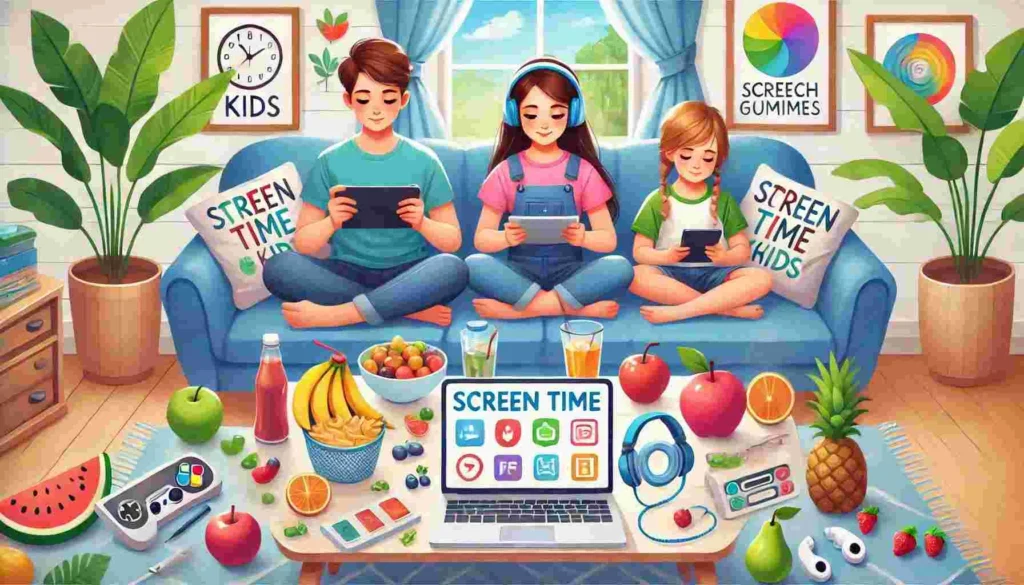
Screen Time Guidelines for Kids: Setting Healthy Boundaries
Introduction
In today’s digital world, managing children’s screen time has become an essential aspect of parenting. With the rapid growth of technology, kids are exposed to screens at an increasingly young age. While technology offers many benefits, excessive screen time can negatively impact a child’s mental, emotional, and physical health. Setting healthy boundaries for screen time ensures a balanced lifestyle and fosters positive habits for their future. This blog outlines practical strategies and evidence-based guidelines to help parents navigate screen time effectively.
The Importance of Limiting Screen Time
Impact on Physical Health
Excessive screen use can lead to a sedentary lifestyle, increasing the risk of childhood obesity. Prolonged hours in front of screens can also contribute to poor posture, eye strain, and sleep disturbances. Encouraging regular breaks and incorporating physical activities are crucial for a child’s overall well-being.
Key Points:
- Encourage outdoor play to reduce screen dependency.
- Set a rule for “tech-free” hours to promote physical engagement.
- Educate kids on the importance of protecting their eyesight with regular breaks (e.g., the 20-20-20 rule).
Effects on Mental and Emotional Health
Studies reveal that unregulated screen time may contribute to anxiety, depression, and reduced attention spans in children. Additionally, social media and online games can expose kids to cyberbullying or unrealistic societal expectations, affecting their self-esteem.
Suggestions for Parents:
- Monitor content and ensure age-appropriate exposure.
- Foster open communication about online experiences to address concerns early.
- Balance screen activities with offline hobbies such as art, music, or reading.
Setting Realistic Screen Time Boundaries
Understanding Age-Appropriate Guidelines
The American Academy of Pediatrics (AAP) recommends the following screen time limits for children:
- 0–18 months: Avoid screen time except for video chatting.
- 18 months–2 years: Introduce high-quality educational programs with parental interaction.
- 3–5 years: Limit to one hour per day of supervised screen time.
- 6–12 years: Set consistent limits and prioritize educational content.
- 13–18 years: Balance recreational and educational screen use, ensuring it doesn’t interfere with sleep or physical activity.
Creating a Family Media Plan
A family media plan is a collaborative approach to setting screen time rules that suit your household’s values and lifestyle. It ensures everyone is on the same page regarding digital consumption.
Steps to Develop a Media Plan:
- Define Screen-Free Zones: For example, no devices during meals or in bedrooms.
- Set Daily Limits: Allocate specific time slots for recreational screen use.
- Promote Quality Content: Prioritize apps, shows, or games that encourage learning and creativity.
- Be a Role Model: Demonstrate healthy screen habits as a parent.
Practical Strategies for Screen Time Management
Establishing Routine and Consistency
Kids thrive in structured environments. Setting clear rules for screen use, such as after completing homework or chores, helps instill discipline and accountability.
Actionable Tips:
- Use timers to signal the end of screen sessions.
- Create a schedule that includes screen-free activities like family board games or storytelling.
- Reward compliance with non-digital incentives like extra playtime or family outings.
Encouraging Offline Engagement
A child’s creativity and curiosity flourish when they engage in non-digital activities. Encourage hobbies like drawing, building puzzles, or gardening to keep them entertained without screens.
Ideas for Offline Activities:
- Organize playdates or group sports to promote social skills.
- Introduce DIY crafts or science experiments to spark interest.
- Plan regular family outings to museums, parks, or zoos.
Advanced Strategies for Managing Screen Time
Setting Clear Consequences for Overuse
Even with established boundaries, children may push limits. It’s essential to implement consistent and reasonable consequences for excessive screen use to reinforce guidelines effectively.
Effective Consequence Ideas:
- Loss of Screen Privileges: If a child exceeds their screen time limit, they lose screen time privileges the following day.
- Additional Chores: Assigning extra responsibilities encourages accountability.
- Reduced Weekend Screen Time: For consistent overuse, reduce screen access during weekends or leisure time.
Consequences should be fair, directly related to screen time behavior, and communicated clearly to avoid confusion.
Using Parental Controls and Monitoring Tools
Parental controls are a valuable tool for managing screen time, filtering content, and keeping track of digital usage. They can help enforce boundaries and ensure children are engaging in safe online activities.
Popular Parental Control Options:
- Screen Time Limits: Features available on most devices allow parents to set daily usage caps.
- Content Filters: Tools like Google Family Link or Apple Screen Time block inappropriate websites and apps.
- Activity Monitoring: Apps such as Qustodio and Bark provide insights into your child’s screen habits and online interactions.
Parental controls offer peace of mind, but they should always be paired with open communication and trust-building.
Balancing Digital Learning and Recreational Screen Use
Differentiating Between Educational and Recreational Use
Not all screen time is equal. Educational screen use, such as schoolwork, online classes, or research, should be prioritized over recreational activities like gaming or social media.
Tips for Balance:
- Prioritize Homework First: Ensure all assignments are complete before recreational screen time.
- Set Learning Goals: Encourage children to achieve specific educational milestones before engaging in non-educational activities.
- Use Educational Apps: Platforms like Khan Academy, Duolingo, or ABCmouse make learning fun and interactive.
Balancing these types of screen use helps children understand that screens can be tools for growth, not just entertainment.
Encouraging Productive Digital Use
Screens can be a gateway to creativity and skill-building when used wisely. Encourage children to use their screen time for productive purposes beyond passive consumption.
Productive Screen Time Ideas:
- Coding Apps: Tools like Scratch or Tynker introduce kids to programming in a fun way.
- Creative Platforms: Apps for drawing, music creation, or animation (e.g., Procreate or GarageBand) foster creativity.
- Skill Development: Encourage learning new skills like photography, language learning, or video editing through guided apps and tutorials.
By guiding children toward productive digital use, you instill a mindset that screens are tools for creativity and growth.
Screen Time and Sleep: Why It Matters
The Impact of Screens on Sleep Quality
Excessive screen time, especially before bed, can significantly impact a child’s sleep. The blue light emitted by screens suppresses melatonin production, making it harder for kids to fall asleep.
Common Sleep Issues Related to Screen Time:
- Difficulty Falling Asleep: Screens delay melatonin, a hormone that regulates sleep.
- Poor Sleep Quality: Interrupted sleep patterns can lead to fatigue and reduced focus.
- Night Waking: Exposure to stimulating content can lead to disturbed sleep.
Creating a Screen-Free Bedtime Routine
To promote better sleep hygiene, establish a screen-free bedtime routine that relaxes and prepares your child for rest.
Effective Bedtime Strategies:
- Screen Curfew: Stop all screen use at least one hour before bedtime.
- Relaxation Activities: Encourage reading a physical book, taking a warm bath, or practicing relaxation exercises.
- Dim the Lights: Soft lighting signals the brain that it’s time to wind down.
A consistent bedtime routine helps children sleep better, improves their mood, and supports overall health.
Building Sustainable Long-Term Screen Habits
Teaching Self-Regulation Skills
Ultimately, the goal is to help children develop the skills to manage their screen time independently. Teaching self-regulation empowers them to make responsible choices as they grow.
Ways to Teach Self-Regulation:
- Goal Setting: Help children set daily goals for both screen and non-screen activities.
- Time Management: Teach them to allocate their time effectively between schoolwork, play, and relaxation.
- Reflection: Encourage kids to reflect on how screen time makes them feel. Are they happier, more tired, or more stressed?
Over time, these skills will help your children create a balanced digital life without constant supervision.
Leading by Example
Children are more likely to follow screen time guidelines when they see their parents modeling healthy habits. Demonstrate a balanced approach to technology by setting limits for yourself.
Parental Role Modeling Tips:
- Tech-Free Family Time: Dedicate specific times, such as dinner, for family interactions without screens.
- Digital Detox Days: Schedule occasional “no-tech” days to focus on family bonding and outdoor activities.
- Mindful Screen Use: Avoid mindless scrolling and be intentional about your own screen time.
By practicing what you preach, you create a household culture that values balance and well-being.
Effective Strategies to Enforce Screen Time Limits
Setting Screen-Free Zones in the Home
Designating certain areas of the home as screen-free helps create boundaries that kids can easily understand and follow. These zones encourage more interaction, creativity, and relaxation.
Examples of Screen-Free Zones:
- Dining Areas: No screens during meals to promote family bonding and mindful eating.
- Bedrooms: Keeping screens out of bedrooms helps improve sleep quality and reduces late-night usage.
- Playrooms: Encourage creative play, art, and physical activity instead of relying on digital entertainment.
By clearly defining these spaces, children learn to associate specific environments with screen-free activities, fostering a balanced routine.
Implementing Screen-Free Times
Just like screen-free zones, establishing screen-free times during the day helps manage digital exposure. Routine breaks from screens give children opportunities to engage in physical activities, social interactions, and hobbies.
Suggested Screen-Free Times:
- Before School: Encourage reading, breakfast, or light exercise to start the day off-screen.
- During Homework Hours: Ensure focus and productivity by limiting distractions.
- Before Bedtime: A screen-free hour before bedtime helps kids wind down and improves sleep quality.
Consistency is key. Over time, these breaks will become natural parts of your child’s daily schedule.
Encouraging Healthy Digital Habits
Promoting Digital Literacy
In today’s world, digital literacy is as important as traditional literacy. Teaching children how to use technology responsibly helps them navigate the digital space safely and effectively.
Key Digital Literacy Skills:
- Critical Thinking: Teach kids to question the reliability of online information and identify credible sources.
- Privacy Awareness: Help them understand the importance of protecting personal information and avoiding oversharing.
- Cybersecurity: Explain safe practices like using strong passwords and recognizing phishing attempts.
By encouraging these skills, you empower your children to use screens wisely, enhancing their safety and independence online.
Rewarding Non-Screen Activities
Positive reinforcement can motivate children to reduce screen time and engage in healthier activities. By offering rewards for completing non-digital tasks, kids learn that fun isn’t limited to screens.
Ideas for Non-Screen Rewards:
- Extra Playtime: Allow additional outdoor play or favorite activities.
- Family Outings: Plan trips to parks, museums, or amusement centers.
- Special Treats: Offer a favorite snack or a small toy for consistent screen-free behavior.
These rewards create positive associations with non-screen activities, making it easier for children to transition away from digital entertainment.
Balancing Screen Time with Physical Activity
Prioritizing Outdoor Play
Outdoor activities are vital for a child’s physical health, creativity, and social development. Encouraging kids to spend time outdoors helps offset the sedentary nature of screen use.
Fun Outdoor Activities:
- Sports and Games: Organize soccer, basketball, or tag games to promote fitness.
- Nature Walks: Explore parks or hiking trails to connect with nature.
- Biking and Skating: These activities are great for building coordination and stamina.
Scheduling regular outdoor play keeps children active and reduces reliance on screens for entertainment.
Incorporating Exercise into Daily Routines
Physical activity doesn’t always require structured playtime. Simple exercises can be integrated into daily routines, making movement a natural part of the day.
Easy Ways to Add Exercise:
- Morning Stretching: Start the day with a quick stretching or yoga routine.
- Family Workouts: Engage in fun group exercises like dancing, jumping jacks, or obstacle courses.
- Active Chores: Involve children in tasks like gardening, cleaning, or organizing.
These small efforts ensure children remain physically active and balance their screen time with movement.
Addressing Resistance to Screen Limits
Understanding Common Pushbacks
It’s natural for children to resist screen time limits, especially if they’re accustomed to unrestricted use. Understanding their objections helps you address them constructively.
Typical Pushbacks:
- “I’m bored!” Offer a variety of engaging alternatives like puzzles, crafts, or reading.
- “Everyone else gets more screen time.” Explain your family’s values and focus on what’s healthy.
- “I need it for homework.” Set specific times for educational use and monitor their progress.
Empathy and communication are key. Acknowledge their feelings while reinforcing the importance of balance and health.
Staying Firm and Consistent
Consistency is crucial when enforcing screen time rules. Mixed messages can lead to confusion and frequent arguments.
Tips for Consistency:
- Stick to the Rules: If screen time is limited to one hour, enforce it even when it’s challenging.
- Use Timers: Visual and audible cues help children understand when time is up.
- Regular Check-Ins: Review screen time boundaries as a family to ensure everyone stays on track.
Over time, consistent enforcement helps children adapt to the guidelines without constant reminders.
Creating a Balanced Digital Future
Teaching Time Management Skills
As children grow, teaching them how to manage their own screen time prepares them for independence. Time management is a lifelong skill that benefits both their digital and non-digital lives.
Practical Time Management Techniques:
- Daily Schedules: Help kids create a balanced schedule that includes study, play, and screen time.
- Prioritization: Teach them to complete essential tasks before recreational screen use.
- Self-Reflection: Encourage them to review their daily activities and identify areas for improvement.
These skills help children understand the importance of balance and make responsible choices.
Fostering a Healthy Relationship with Technology
Technology isn’t going away, and fostering a healthy relationship with it ensures children grow into mindful digital citizens. The goal is to make screens a tool for learning, creativity, and connection, rather than a source of mindless distraction.
Key Principles for Healthy Tech Use:
- Mindfulness: Encourage kids to ask themselves, “Why am I using this screen?” before starting an activity.
- Balance: Teach the value of moderation and diverse interests.
- Quality Over Quantity: Prioritize high-quality content and meaningful interactions over passive consumption.
By fostering these principles, you help children use technology in ways that enhance their lives rather than detract from them.
Fun and Engaging Screen-Free Activities for Kids
Creative Indoor Activities
Sometimes, weather or circumstances might keep children indoors, but that doesn’t mean they need to rely on screens for entertainment. There are plenty of activities that inspire creativity, learning, and fun without digital devices.
Screen-Free Indoor Ideas:
- Arts and Crafts: Encourage drawing, painting, or DIY projects like making friendship bracelets or homemade puppets.
- Puzzle Challenges: Jigsaw puzzles, brain teasers, and crosswords stimulate critical thinking.
- Storytelling and Reading: Have children create their own stories or act out a play. Reading books together also fosters imagination.
- Cooking Together: Get kids involved in making simple recipes or baking treats. This helps develop practical skills and creativity.
These activities not only reduce screen dependency but also help build skills and family connections.
Outdoor Adventures
Fresh air and physical movement are essential for a child’s development. Outdoor activities provide an excellent way to balance screen time with active play.
Fun Outdoor Adventures:
- Scavenger Hunts: Organize a themed scavenger hunt in your backyard or a local park.
- Gardening: Let children plant flowers, vegetables, or herbs and teach them how to care for plants.
- Sports and Games: Classic games like hide-and-seek, tag, or hopscotch keep kids moving and socializing.
- Nature Exploration: Go on hikes, nature walks, or bike rides to explore new places and learn about the environment.
Outdoor play improves physical health, boosts mood, and gives children a break from digital stimulation.
Family Bonding Activities
Spending quality time together as a family helps reinforce healthy screen time habits and strengthens relationships.
Family-Friendly Ideas:
- Board Game Nights: Choose games suitable for all ages to foster teamwork and friendly competition.
- Movie Nights (Limited): Occasionally, enjoy a family-friendly movie, making sure it’s balanced with other screen-free activities.
- DIY Projects: Work together on fun projects like building a birdhouse, creating homemade decorations, or assembling model kits.
- Weekly Challenges: Create fun challenges such as who can read the most books, finish the most puzzles, or complete the most chores in a week.
These shared experiences help create lasting memories and encourage kids to rely less on screens for entertainment.
How to Create a Tech-Positive Household
Embrace Technology as a Tool, Not a Distraction
Technology can be an incredible resource for learning and productivity when used intentionally. Shifting the perception of screens from mindless entertainment to valuable tools helps build a healthier relationship with technology.
Tips for Positive Tech Use:
- Purpose-Driven Use: Encourage kids to use screens for learning new skills, completing homework, or exploring creative projects.
- Tech for Connection: Use technology to connect with family members via video calls or engage in collaborative activities like virtual art classes.
- Balance and Intent: Teach children to ask themselves, “Why am I using this device?” before picking it up.
By fostering this mindset, screens become a resource rather than a constant source of distraction.
Create a Family Digital Agreement
A digital agreement is a set of guidelines that the entire family agrees to follow. This helps set expectations and ensures consistency.
Steps to Create a Digital Agreement:
- Collaborate: Involve children in setting the rules so they feel a sense of ownership.
- Outline Rules Clearly: Define limits for screen time, approved apps, and screen-free zones.
- Review and Adjust: Revisit the agreement regularly and make changes based on what’s working or not.
This agreement promotes accountability and gives everyone a clear understanding of digital boundaries.
Handling Screen Time During Special Occasions
Managing Screen Time on Holidays and Vacations
Special occasions can make it challenging to enforce screen time rules. However, maintaining boundaries during holidays or trips helps children stay connected with the real world.
Tips for Balanced Screen Use:
- Set Clear Expectations: Explain ahead of time how much screen time is allowed during holidays.
- Plan Engaging Activities: Offer fun alternatives like games, sightseeing, or group activities to minimize the desire for screens.
- Allow Limited Flexibility: It’s okay to relax rules slightly, but ensure it doesn’t become a habit once the holiday ends.
A balanced approach ensures special occasions remain memorable and screen-free.
Handling Screens in Social Settings
Children may feel left out if their friends have unrestricted screen access. Teach them how to handle these situations without feeling isolated.
Strategies for Social Settings:
- Role Play Scenarios: Practice how they can politely decline excessive screen use.
- Suggest Alternatives: Encourage them to propose other fun activities when with friends.
- Stay Involved: Communicate with other parents to align expectations where possible.
Helping kids navigate peer pressure teaches them valuable social skills and reinforces healthy habits.
Long-Term Strategies for Digital Wellness
Teaching Digital Detox Techniques
Regular digital detoxes allow children to reset and reflect on their screen habits. Integrating short detoxes into their routine promotes long-term digital wellness.
Easy Digital Detox Ideas:
- Weekly Detox Day: Designate one day a week for a full break from screens.
- Tech-Free Mornings: Start the day with no screens until lunchtime.
- Mindful Evenings: Avoid screens after dinner, focusing instead on family time or relaxation.
These small breaks improve mental clarity, reduce anxiety, and promote mindfulness.
Encouraging Lifelong Balance
The ultimate goal is for children to grow into adults who can manage their screen time effectively. Equip them with the tools and understanding to make healthy digital choices.
Key Lessons for Lifelong Balance:
- Self-Awareness: Teach kids to recognize when screens are affecting their mood or productivity.
- Prioritization: Help them understand the importance of balancing responsibilities, relationships, and recreation.
- Healthy Hobbies: Encourage lifelong hobbies like reading, sports, art, or music that don’t rely on screens.
Fostering these skills ensures children grow up with a balanced approach to technology.



